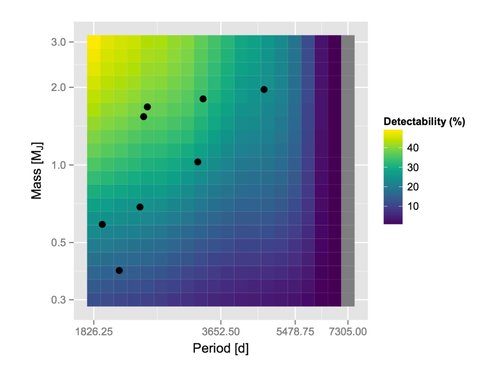2015 Annual Science Report
 NASA Ames Research Center
Reporting | JAN 2015 – DEC 2015
NASA Ames Research Center
Reporting | JAN 2015 – DEC 2015
Modeling and Observations of Exoplanets
Project Summary
The focus of this project is to use the Doppler velocity technique to detect and characterize extrasolar planets and use exoplanet data to establish the nature and diversity of planetary systems in the galaxy, with an emphasis on establishing the abundance of habitable planets in the universe.
Project Progress
Co-I Laughlin lead our effort at UCSC to detect and characterize extrasolar planets. The work done in the past year involved both theoretical studies of planet formation and evolution and direct planet detection through observational activity using the new Automated Planet Finder (APF) telescope on Mt Hamilton. Over the past year, the APF has come into full-fledged production mode, and is using the Doppler velocity technique to actively detect planetary systems orbiting bright nearby stars. Highlights of recent work include the discovery of a remarkable 6-planet system orbiting the sun-like star HD 219134 [1]. The low-mass innermost planet of the HD 219134 system has been observed to transit the host star, and will thus be an important target for JWST (in large part because the host star is so bright).
Figure 1, which is taken from Rowan et al. [2], is a summary of our ongoing Doppler velocity planet search with the Keck Telescope. The diagram charts the region of parameter space that is occupied by “true” Jupiter-like planets, with masses between 30% and 3x that of Jupiter, and orbital periods ranging from half that of Jupiter to twice that of Jupiter. The diagram shows the eight Jupiter analogs that we have discovered orbiting the 1,122 stars in our sample, along with our sensitivity to a planet in each part of the mass-period plane. The upshot of this figure is that true Jupiters – and by extension, our own Solar System – are rare. At most, 3% of Sun-like stars can host planetary systems that bear a fundamental resemblance to our own. While this result does not yet tell us the frequency of Earth analogs, it does tell us that the variety of planetary systems is far larger than what we would guess from extrapolating from the Sun’s family of planets.
References:
[1] Vogt, S. S., Burt, J., Meschiari, S., Butler, R. P., Henry, G. W., Wang, S., Holden, B., Gapp, C., Hanson, R., Arriagada, P., Keiser, S., Teske, J., and Laughlin, G. (2015) Astrophys. J., 814, 12.
[2] Rowan, D., Meschiari, S., Laughlin, G., Vogt, S., Butler, R. P., Burt, J., Wang, S., Holden, B., Hanson, R., Arriagada, P. (2016) Astrophys. J., 814, 2.
Publications
-
Burt, J., Holden, B., Hanson, R., Laughlin, G., Vogt, S., Butler, P., … Deich, W. (2015). Capabilities and performance of the Automated Planet Finder telescope with the implementation of a dynamic scheduler. Journal of Astronomical Telescopes, Instruments, and Systems, 1(4), 044003. doi:10.1117/1.jatis.1.4.044003
-
Rowan, D., Meschiari, S., Laughlin, G., Vogt, S. S., Butler, R. P., Burt, J., … Diaz, M. (2016). THE LICK-CARNEGIE EXOPLANET SURVEY: HD 32963—A NEW JUPITER ANALOG ORBITING A SUN-LIKE STAR. The Astrophysical Journal, 817(2), 104. doi:10.3847/0004-637x/817/2/104
-
Vogt, S. S., Burt, J., Meschiari, S., Butler, R. P., Henry, G. W., Wang, S., … Laughlin, G. (2015). SIX PLANETS ORBITING HD 219134. The Astrophysical Journal, 814(1), 12. doi:10.1088/0004-637x/814/1/12
-
PROJECT INVESTIGATORS:
-
PROJECT MEMBERS:
Jennifer Burt
Graduate Student
Angie Wolfgang
Graduate Student
-
RELATED OBJECTIVES:
Objective 1.1
Formation and evolution of habitable planets.
Objective 1.2
Indirect and direct astronomical observations of extrasolar habitable planets.

